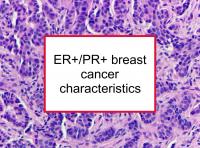Up to two-thirds of invasive breast cancers are classified as hormone receptor positive (ER+/PR+), having both estrogen receptor (ER+) and progesterone receptor (PR+) positive tumor receptor status. ER+/PR+ breast cancer either overexpresses the HER2 gene (ER+/PR+/HER2+) or not (ER+/PR+/HER2-).
Compounds that regulate ER expression, oppose the production of estrogen in the body (i.e., oppose aromatase), or inhibit the binding of estrogen to estrogen receptors are among those used to treat this type of breast cancer.
ER+/PR+ subtype has the most favorable prognosis
Generally speaking, breast cancer patients with ER+/PR+ tumors have a more favorable prognosis than those with other estrogen/progesterone subtypes (ER+/PR-, ER-/PR+, or ER-/PR-). Tumors with a large number of estrogen receptors are associated with better prognosis than those with few. Please see our article on ER+/PR+ breast cancer prognosis.
Some breast cancer risk factors are hormone receptor specific
Late age at first period, early age at first birth, and increasing number of children have all been found to be associated with reduced risk of breast cancer, but only among those with ER+/PR+ tumors. Women with a history of migraine headaches are also less likely to develop ER+/PR+ breast cancer.
Use of hormone replacement therapy (HRT), also known as menopausal hormone therapy, has been reported to increase the risks of both ER+/PR+ and ER+/PR- tumors (but not ER- tumors). Women with high breast density have an increased risk for ER+/PR+ and mixed hormone receptor tumors, but the association is less clear for ER-/PR- tumors. On the other hand, consumption of alcohol increases breast cancer risk for all ER/PR subtypes, as does a family history of breast cancer.
Patients with ER+/PR+ BC have opportunity to influence prognosis
Those with ER+/PR+ breast cancer appear to have the greatest opportunity to improve their prognosis through diet, exercise, and by avoiding exposure to endocrine disruptors. This advantage arises from the fact that this is the most hormonally-driven subtype. Please see our article on what ER+/PR+ breast cancer patients and survivors should eat.
Sources of information provided in this webpage
The information above, which is updated continually as new research becomes available, has been developed based solely on the results of academic studies. Clicking on any of the underlined words will take you to its tag or webpage, which contain more extensive information.
Below are links to 20 recent studies concerning this topic. For a more complete list of studies, please click on ER+/PR+.
